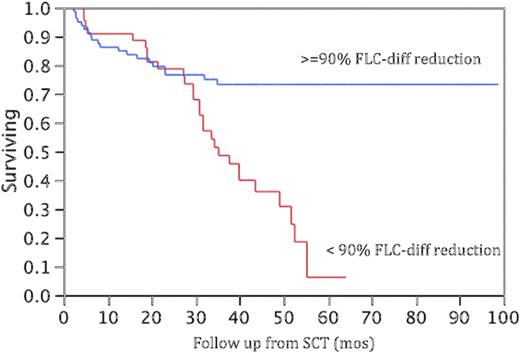Abstract
Abstract 747
Light chain amyloidosis is a monoclonal plasma cell proliferative disorder characterized by multiorgan deposition of monoclonal light chain derived amyloid fibrils. The diffuse organ infiltration by the amyloid fibrils leads to various AL related clinical features. Therapy of AL has been primarily aimed at elimination or control of the monoclonal plasma cells, thus decreasing the light chain available for amyloid formation. Assessment of response to therapy has been grouped into hematological response demonstrating elimination or reduction of the monoclonal population and organ response demonstrating actual improvement in its structure or function. Given the potentially long delay in observing organ improvement, hematological response has been the surrogate short term marker for long term outcome given the relatively rapid decline seen in the monoclonal protein with effective therapy, as well as studies showing improved long term outcome with a hematological response, especially complete response. However, conventional hematological response criteria give priority to the intact monoclonal protein rather than the light chain, which is the amyloidogenic protein. We hypothesized that a light chain response will correlate better with outcome than changes in the intact monoclonal protein levels.
We identified 348 patients who had undergone stem cell transplant (SCT) for AL from among a large group of patients undergoing different treatments for AL, and in whom serial tests results were available. We identified the lowest value attained following SCT for various hematological response parameters (intact serum M-protein [MP], the difference between involved and uninvolved serum free light chain [FLC-diff], and urine M-protein [UP]) before an alternate therapy was instituted. We first estimated the best cutoff for the degree of change in each parameter that predicted 5-year survival from SCT. Cox proportional hazards model was used for multivariable analysis of factors influencing overall survival (OS).
We first examined the relative contribution of the MP and the FLC-diff on the overall survival following transplant. The best cutoff for reduction in FLC-diff to predict OS at 5 years from SCT was 88% if all patients were considered and 90% if only those with a baseline FLC diff > 7.5 mg/dL were considered. The best cutoff for MP reduction was 40% for 5 year survival for all patients and 67% for those with a baseline MP > 1.0 gm/dL. We then looked at the impact of FLC reduction and MP reduction in a multivariable analysis using OS as endpoint. For all patients, FLC reduction, but not MP reduction significantly impacted outcome, and results were similar when considering patients with MP>1.0 gm/dl and FLC-diff > 7.5 mg/dl at baseline. Among those with a baseline FLC-diff >7.5 mg/dL (n=125), the overall survival was 35 mos from SCT for those with less than 90% decrease in FLC-diff (45 pts) compared to not reached for those with at least 90% decrease (80 pts); P < 0.001 (Figure).
The current study supports the notion that reductions in the free light chain parameters represent a more useful measure of hematological response that translates into better overall survival and possible better chance at organ improvement. A reduction in the FLC difference of 90% appears to correlate best with prolonged survival.
Kumar:CELGENE: Research Funding; MILLENNIUM: Research Funding; BAYER: Research Funding; GENZYME: Research Funding; NOVARTIS: Research Funding. Gertz:celgene: Honoraria; millenium: Honoraria, Membership on an entity's Board of Directors or advisory committees. Lacy:celgene: Research Funding.
Author notes
Asterisk with author names denotes non-ASH members.


This feature is available to Subscribers Only
Sign In or Create an Account Close Modal